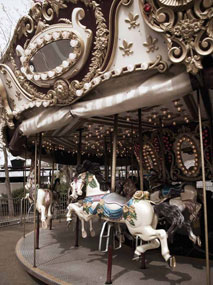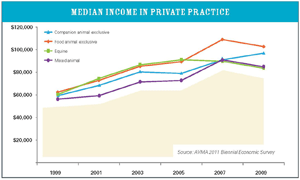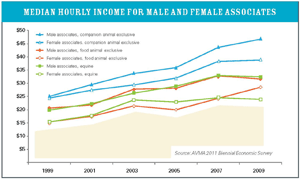Some incomes rise, but others fall
Mean income increased between 2007 and 2009 for companion animal–exclusive practitioners but decreased during that period for private practitioners in other categories.
That's according to the recently released 2011 AVMA Report on Veterinary Compensation, which draws on results from AVMA Biennial Economic Surveys performed in 2010 and in previous years. The 2010 survey collected data for the 2009 calendar year.
The report reveals that mean income for private practitioners overall increased between 2007 and 2009, from $115,447 to $121,303, because of the high proportion of companion animal–exclusive practitioners.

"It's important to note that average salaries did decline in some types of private practice, including equine and large animal, but these declines clearly could have been worse," said Dr. Karen E. Felsted, chief executive officer of the National Commission on Veterinary Economic Issues. "We know that veterinary visits have declined due to the recession. Veterinarians are not recession-proof."
In 2009, food animal–exclusive veterinarians had the highest mean income among all private practice categories, at $131,479. The lowest mean incomes in private practice were in the categories of food animal–predominant practice, at $102,231, and mixed animal practice, at $107,064.
Mean income for veterinarians in public and corporate practice increased between 2007 and 2009, from $121,560 to $124,232. The top-earning veterinarians worked in industry, with a mean income of $167,415 in 2009.
In an ongoing trend, female veterinarians had lower mean incomes than male veterinarians in private practice and in public and corporate practice.
Income changes
Before the recent recession, mean incomes for private practitioners in every category had increased for each two-year period between 1999 and 2007.
The trend continued for companion animal–exclusive practitioners between 2007 and 2009, with mean income increasing from $113,373 to $124,768. Median income for this category increased from $91,000 to $97,000.
"Even in the face of this economy, there are certain groups of people that will continue to do as much for their pets as they can," said Dr. Gregg K. Takashima of Parkway Veterinary Hospital in Lake Oswego, Ore., president of the American Animal Hospital Association.
Dr. Takashima said total patient visits have decreased recently at his companion animal–exclusive practice, but revenues have increased somewhat. The practice has not raised prices aggressively, but it has been offering additional services.
Revenue growth appears to have slowed in companion animal–exclusive practice, Dr. Takashima said. Recent AAHA surveys found that revenue growth for companion animal–exclusive practices was 4.7 percent between 2008 and 2009, in comparison with 10.7 percent between 2006 and 2007.
In equine practice, mean income decreased from $131,195 in 2007 to $126,641 in 2009. Median income decreased from $91,000 to $85,000.
The economic downturn led to a loss of discretionary income for horse owners to spend on their horses and on breeding of more horses, said Dr. William A. Moyer, president of the American Association of Equine Practitioners and a professor at Texas A&M University.
"The horse world, for the most part, is financed by discretionary dollars," Dr. Moyer said. "At Texas A&M, we're seeing fewer cases, and often we're seeing less dollars spent on a given case."
Equine practitioners still had the second highest mean income in private practice for 2009, Dr. Moyer noted, indicating to him that veterinarians can make a good living in equine practice.
In food animal–exclusive practice, mean income decreased from $139,612 in 2007 to $131,479 in 2009, with median income decreasing from $109,000 to $103,000. Mean income also decreased in food animal–predominant practice, from $107,330 in 2007 to $102,231 in 2009.
The decrease in income for food animal practitioners partially reflects the fact that dairy producers had a very bad year in 2009, said Dr. Brian J. Gerloff of Farm Animal Veterinary Services in Marengo, Ill., president-elect of the American Association of Bovine Practitioners. In 2009, feed prices were high, and milk prices were low.
"In terms of our clients, I think it was a historically devastating year," Dr. Gerloff said. "My clients who hadn't had to borrow in 10 to 15 years, had to borrow money."
Income comparisons
During the 1999–2009 time frame, veterinarians in mixed animal and food animal–predominant practice had median incomes that were lower than or, at most, equal to the median incomes of veterinarians in food animal–exclusive, companion animal–exclusive, and equine practice.
"When you're trying to be all things to all people, your efficiency probably goes down," said Dr. Dean E. Christianson of Ashley Veterinary Clinic in Ashley, N.D., president of the Academy of Rural Veterinarians.
Dr. Christianson said his food animal–predominant practice is efficient when working with beef cattle but less so with horses and small animals.
Dr. Christianson went on to note that the cost of living is somewhat lower in the rural areas, where mixed animal practitioners and food animal practitioners tend to work.
The Academy of Rural Veterinarians is promoting the message to veterinary students that veterinarians can make a good living in rural practice. Among its efforts to improve retention in rural practice, the group recently held a symposium on management of rural practices and has created an electronic mailing list for new rural practitioners to discuss concerns.
The AVMA Biennial Economic Survey revealed ongoing income disparities by gender. Female veterinarians in private practice had a median income of $79,000 in 2009, while their male counterparts had a median income of $115,000. Female owners in every category of private practice had a lower median income and median income per hour than did their male counterparts.
Similarly, for every private practice category, median income and median income per hour were lower for female associates in 2009 than for their male counterparts. Nevertheless, female associates with one to two years of experience had a higher median income than male associates with one to two years of experience.
A 2007 research paper "A Behavioral Study of Pricing Decisions for Professional Services: A Focus on Gender" from the Southern Methodist University Cox School of Business reported on a study that found female practice owners tend to set lower prices than male practice owners for the same services.
According to the abstract, "Women professionals were influenced by the number of the associates in their practices and the clients' characteristics in setting prices while men's prices were unaffected by such considerations."
Public and corporate practice
Between 2007 and 2009, median incomes for veterinarians in every category of public and corporate practice increased or stayed the same.
Median incomes stayed the same for veterinarians working in industry or academia. Industry veterinarians had a median income of $148,000 in 2009, and veterinarians at a college or university had a median income of $103,000.
Veterinarians working for a state or local government had a median income of $106,000 in 2009, up from $94,000 in 2007. Median income for veterinarians working in the federal government was $103,000 in 2009, up from $97,000 in 2007.
Veterinarians in the uniformed services had a median income of $85,000 in 2009, up from $79,000 in 2007.
Median income was lower for female veterinarians than for male veterinarians in public and corporate practice overall and within almost every category in 2009. Female and male veterinarians in the federal government had the same median income, at $103,000.
Female veterinarians in public and corporate practice with one to two, three to four, and five to nine years of experience had a higher median income than male veterinarians with the same amount of experience.
Specialists continue to have a lower median income in public and corporate practice than they do in private practice. Specialists had a median income of $133,000 in public and corporate practice, in comparison with a median income of $157,000 in private practice.
Reports available
The AVMA Biennial Economic Survey collects data not only on veterinary compensation but also on the finances of private practices, including practice revenues and expenses. Statistics for the 2009 calendar year appear in the 2011 AVMA Report on Veterinary Compensation and the 2011 AVMA Report on Veterinary Practice Business Measures.
The AVMA has released the reports in book form and as downloadable PDF files. The reports are available for purchase either by calling the AVMA Store at (800) 248-2862, Ext. 6655, or visiting https://ebusiness.avma.org/ProductCatalog/ProductCategory.aspx?ID=120.
The AVMA will conduct the next economic survey in 2012 to collect data for the 2011 calendar year.

